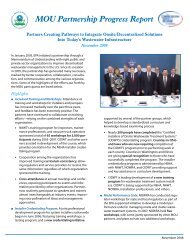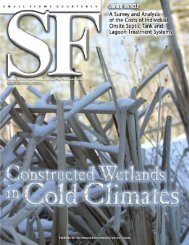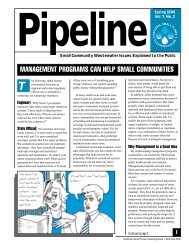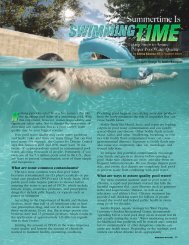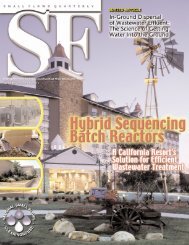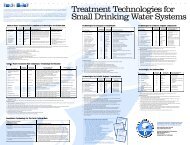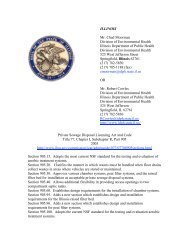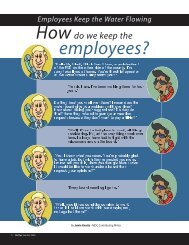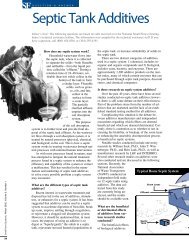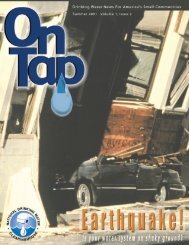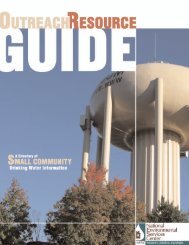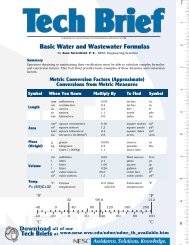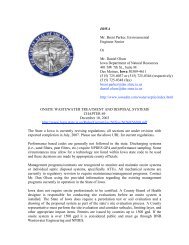Download - National Environmental Services Center - West Virginia ...
Download - National Environmental Services Center - West Virginia ...
Download - National Environmental Services Center - West Virginia ...
Create successful ePaper yourself
Turn your PDF publications into a flip-book with our unique Google optimized e-Paper software.
J U R I E D A R T I C L E<br />
Small Flows Quarterly, Fall 2004, Volume 5, Number 4<br />
44<br />
$160<br />
$140<br />
$120<br />
$100<br />
$80<br />
$60<br />
$40<br />
$20<br />
$0<br />
Stephenville<br />
Clifton<br />
FIGURE 5 Estimated monthly household cost of phosphorus removal for North Bosque WWTPs.<br />
Figure 5. Estimated monthly household cost of phosphorus removal for North Bosque WWTPs.<br />
Cost-Effectiveness<br />
Effectiveness, within a water<br />
quality context, can be considered<br />
an improvement in a water quality<br />
measure that is associated with<br />
impairment. Ambient phosphorus<br />
concentrations in rivers and lakes<br />
have been shown to correlate,<br />
under certain circumstances, with<br />
excessive algal growth. Effectiveness<br />
is here defined as the estimated<br />
TP load removed from WWTP<br />
effluent as a result of phosphorus<br />
control, as reported in Table 2.<br />
While bearing some resemblance<br />
to affordability measures,<br />
cost-effectiveness ratios are more direct<br />
measures of efficiency and are<br />
calculated by dividing the total cost<br />
of phosphorus removal by total<br />
pounds of phosphorus removed.<br />
Cost-effectiveness ratios, as presented<br />
in Table 4, indicate that the cost<br />
of TP removed at North Bosque<br />
WWTPs ranged from $14/lb<br />
($31/kg) for the Stephenville plant<br />
to $331/lb ($730/kg) for the Iredell<br />
plant (an almost 24-fold difference).<br />
Figure 6 reveals the inverse<br />
relationship between estimated<br />
per pound phosphorus removal<br />
costs and plant size.<br />
Trading Implications<br />
The concept of trading marketable<br />
effluent permits to achieve<br />
environmental quality is of relatively<br />
recent origin. Dales (1968) is<br />
Meridian<br />
Hico<br />
Valley Mills<br />
credited with first setting out the<br />
parameters of the type of “cap<br />
and trade” program for water<br />
quality receiving widespread attention<br />
today. The basic components<br />
of the program involve setting<br />
a cap on the total waste load,<br />
issuing emission permits, the aggregate<br />
of which equals the cap,<br />
and allowing the sale and purchase<br />
of permits among dischargers.<br />
Marketable credits are formed<br />
when dischargers with low removal<br />
costs reduce loads below<br />
permitted levels. These credits can<br />
in turn be sold to entities with<br />
high removal costs such that both<br />
parties gain, thereby generating<br />
savings in meeting the total waste<br />
load allocation.<br />
The trading of emission credits<br />
has been implemented in a number<br />
of national programs to<br />
achieve air pollution goals (Tietenberg,<br />
1999). Having achieved<br />
notable successes in the air arena,<br />
economists and policy makers<br />
have investigated the potential of<br />
applying the tradable permit concept<br />
to water pollution control<br />
and several programs have been<br />
developed (e.g., see Environmonist,<br />
1999; EPA, 2001).<br />
In 1996, EPA issued a Draft<br />
Framework for Watershed-Based Trading<br />
(EPA, 1996), which was designed<br />
to promote, encourage, and<br />
facilitate trading wherever possible<br />
provided that equal or<br />
greater water pollution<br />
control can be attained<br />
for an equal or<br />
lower cost. This was<br />
followed in January<br />
2003 by a Water<br />
Quality Trading Policy<br />
to “encourage<br />
states, interstate agencies<br />
and tribes to develop<br />
and implement<br />
water quality trading<br />
programs for nutrients,<br />
sediment and<br />
other pollutants<br />
where opportunities<br />
exist to achieve water<br />
quality improvements<br />
at reduced costs”<br />
(EPA, 2003).<br />
For a trading program<br />
to be successful,<br />
a number of conditions<br />
must apply.<br />
Among them, first,<br />
there must be substantive difference<br />
in compliance costs at the<br />
margin. Second, all potential trading<br />
entities must be given a verifiable<br />
and enforceable pollution reduction<br />
obligation. Third, there<br />
must be legal authority for trading<br />
and an administrative system<br />
must be developed to track trades<br />
and verify compliance. Fourth, the<br />
potential cost savings from trading<br />
should exceed the administrative<br />
and information costs (broadly referred<br />
to as transactions costs) of<br />
setting up and operating the program.<br />
Because the trading among<br />
North Bosque WWTPs involves<br />
only point sources it avoids the<br />
complexities in determining nonpoint<br />
loads (see, e.g., Malik et al.,<br />
1993) that would be required for<br />
“point source/nonpoint source”<br />
trading. In addition, all entities are<br />
subject to the same regulatory<br />
regime—delegated NPDES authority—thereby<br />
further simplifying potential<br />
implementation of a trading<br />
program. For the present example,<br />
we assume that each North<br />
Bosque WWTP is obligated to reduce<br />
loads by an amount equal to<br />
that needed to consistently achieve<br />
ending effluent levels of 1 mg/L.<br />
Trading of TP loads among<br />
North Bosque WWTPs would entail<br />
the removal of TP by one or more<br />
Iredell




